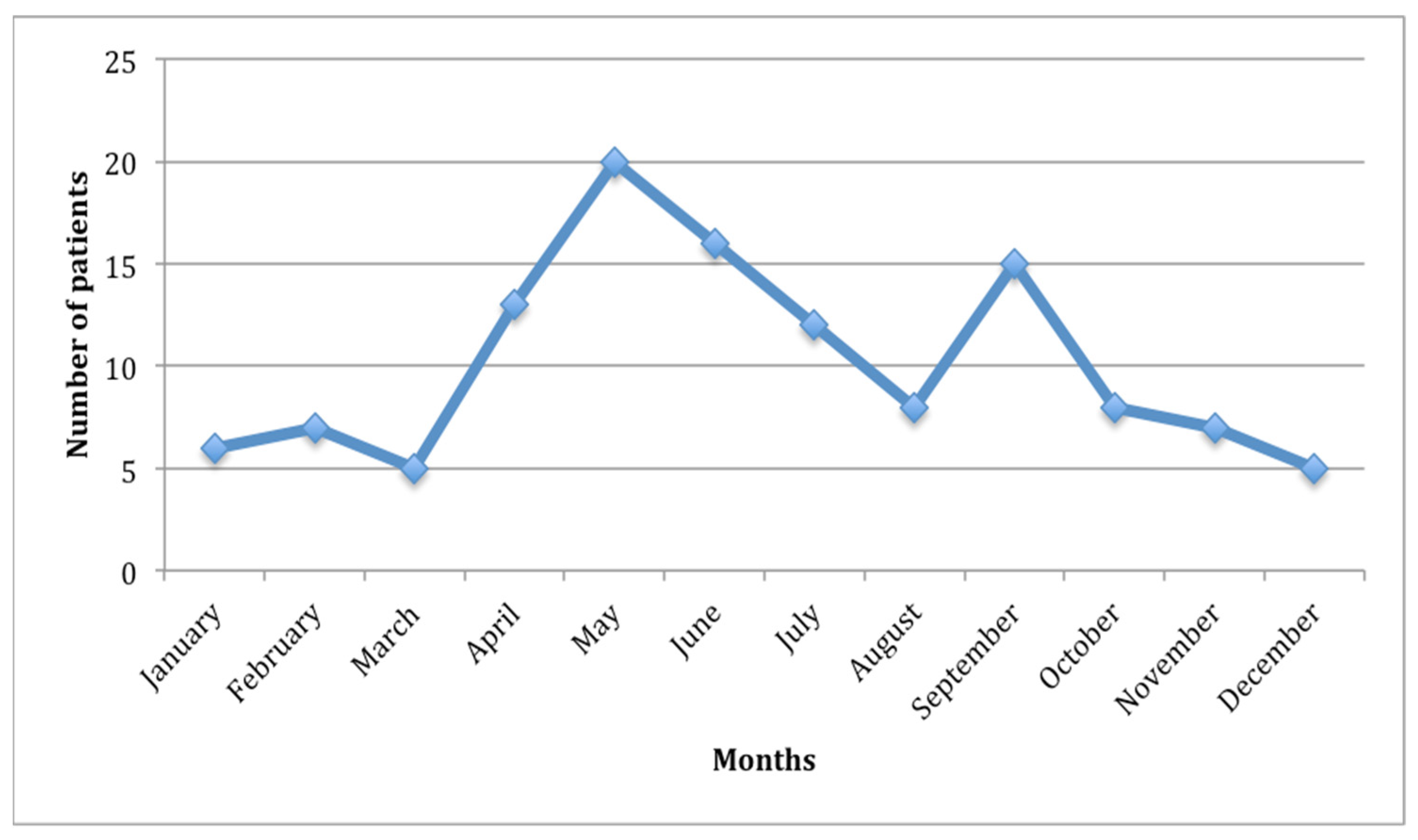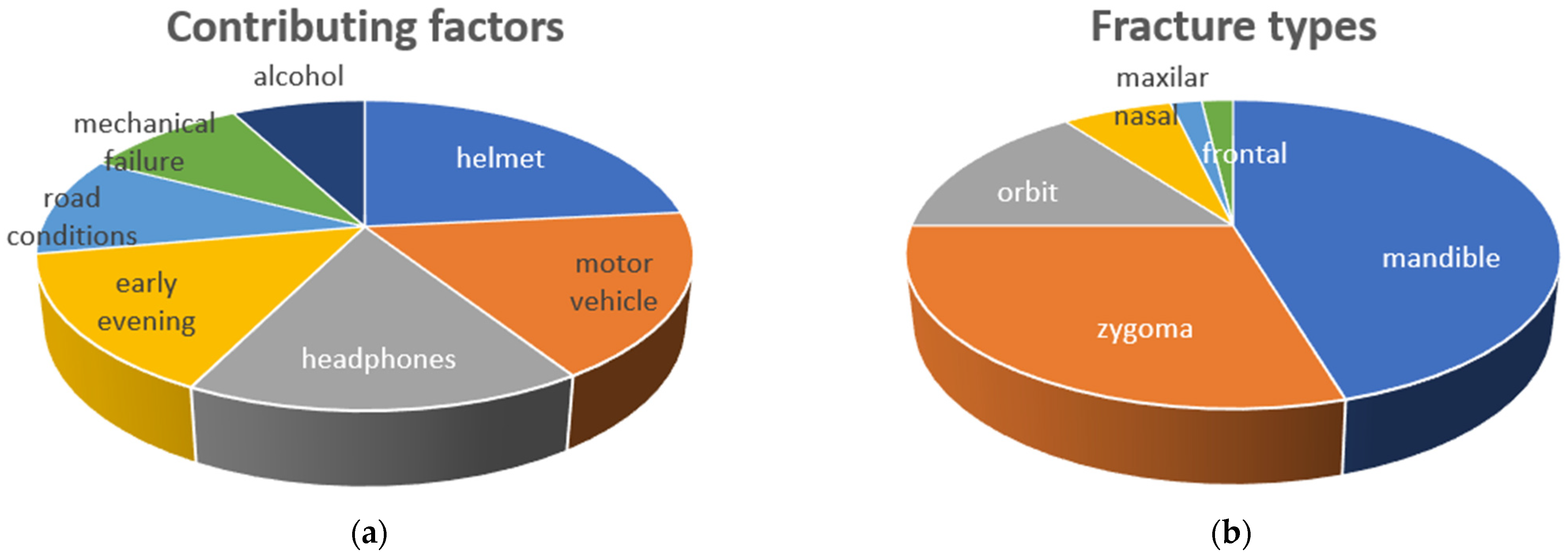Eight-Year Cohort Study Examining Bicycling-Related Maxillofacial Fractures and Factors Contributing to Injury
Abstract
1. Introduction
2. Materials and Methods
2.1. Standard Protocol Approvals and Patient Consent
2.2. Study Design and Subjects
2.3. Statistical Analysis
3. Results
4. Discussion
5. Conclusions
Author Contributions
Funding
Institutional Review Board Statement
Informed Consent Statement
Data Availability Statement
Conflicts of Interest
References
- Bachani, A.M.; Ahsan, H.; Jagnoor, J.; Kobusingye, O.; Tran, N.; Peden, M. Time for action: The critical role of research and data in achieving the targets of the second UN Decade of Action for Road Safety. BMJ Glob. Health 2025, 10, e017488. [Google Scholar] [CrossRef]
- Peden, M.; Scurfield, R.; Sleet, D.; Mohan, D.; Hyder, A.A.; Jarawan, E.; Mathers, C. World Report on Road Traffic Injury Prevention; World Health Organization: Geneva, Switzerland, 2004; pp. 88–94. [Google Scholar]
- Bicsak, A.; Topcuoglu, F.; Hassfeld, S.; Lefering, R.; Bonitz, L.; Stahl, J.P. Concomitant body-wide trauma patterns in patients with head and neck injuries: A comparison based on the trauma register DGU® by the German trauma society and the Dortmund maxillofacial trauma registry. Eur. J. Med. Res. 2025, 30, 371–381. [Google Scholar] [CrossRef] [PubMed]
- Kostakis, G.; Stathopoulos, P.; Dais, P.; Gkinis, G.; Jgoumenakis, D.; Mezitis, M.; Rallis, G. An epidemiologic analysis of 1142 maxillofacial fractures and concomitant injuries. Oral Surg. Oral Med. Oral Pathol. Oral Radiol. 2012, 114, 69–73. [Google Scholar] [CrossRef] [PubMed]
- Van Hout, W.M.M.T.; Van Cann, E.M.; Abbink, J.H.; Koole, R. An epidemiological study of maxillofacial fractures requiring surgical treatment at a tertiary trauma centre between 2005 and 2010. Br. J. Oral Maxillofac. Surg. 2013, 51, 416–420. [Google Scholar] [CrossRef]
- Bourdet, N.; Deck, C.; Serre, T.; Perrin, C.; Llari, M.; Willinger, R. In-depth real-world bicycle accident reconstructions. Int. J. Crashworthiness 2013, 19, 222–232. [Google Scholar] [CrossRef]
- Lee, K.H.; Chou, H.J. Facial fractures in road cyclists. Aust. Dent. J. 2008, 53, 246–249. [Google Scholar] [CrossRef]
- Palmer, A.J.; Si, L.; Gordon, J.M.; Saul, T.; Hitchens, P.L. Accident rates amongst regular bicycle riders in Tasmania. Accid. Anal. Prev. 2014, 72, 376–381. [Google Scholar] [CrossRef]
- Goerke, D.; Zolfaghari, E.; Marek, A.P.; Endorf, F.W.; Nygaard, R.M. Incidence and profile of severe cycling injuries after bikeway infrastructure changes. J. Community Health 2020, 45, 542–549. [Google Scholar] [CrossRef] [PubMed]
- Farkkila, E.M.; Oksanen, E.; Kormi, E.; Suojanen, J. What is the relationship between maxillofacial injury location and associated injuries? J. Oral Maxillofac. Surg. 2024, 82, 800–805. [Google Scholar] [CrossRef]
- Lawson, A.R.; Pakrashi, V.; Ghosh, B.; Szeto, W.Y. Perception of safety of cyclists in Dublin City. Accid. Anal. Prev. 2013, 50, 499–511. [Google Scholar] [CrossRef]
- Vandenbulcke, G.; Thomas, I.; De Geus, B.; Degraeuwe, B.; Torfs, R.; Meeusen, R.; Int Panis, L. Mapping bicycle use and the risk of accidents for commuters who cycle to work in Belgium. Transp. Policy 2009, 16, 77–87. [Google Scholar] [CrossRef]
- Weber, T.; Scaramuzza, G.; Schmitt, K.U. Evaluation of e-bike accidents in Switzerland. Accid. Anal. Prev. 2014, 73, 47–52. [Google Scholar] [CrossRef] [PubMed]
- Juhra, C.; Wieskotter, B.; Chu, K.; Trost, L.; Weiss, U.; Messerschmidt, M.; Malczyk, A.; Heckwolf, M.; Raschke, M. Bicycle accidents: Do we only see the tip of the iceberg? A prospective multi-centre study in a large German city combining medical and police data. Injury 2012, 43, 2026–2034. [Google Scholar] [CrossRef]
- Vandenbulcke, G.; Thomas, I.; Int Panis, L. Predicting cycling accident risk in Brussels: A spatial case-control approach. Accid. Anal. Prev. 2014, 62, 341–357. [Google Scholar] [CrossRef]
- Yamamoto, K.; Matsusue, Y.; Horita, S.; Murakami, K.; Sugiura, T.; Kirita, T. Maxillofacial fractures sustained in bicycle accidents. J. Oral Maxillofac. Surg. 2011, 69, 155–160. [Google Scholar] [CrossRef]
- Wusiman, P.; Maimaitituerxun, B.; Guli, X.; Saimaiti, A.; Moming, A. Epidemiology and pattern of oral and of maxillofacial trauma. J. Craniofac. Surg. 2020, 31, 517–520. [Google Scholar] [CrossRef] [PubMed]
- Boffano, P.; Roccia, F.; Gallesio, C.; Karagozoglu, K.H.; Forouzanfar, T. Bicycle-related maxillofacial injuries: A double-center study. Oral Surg. Oral Med. Oral Pathol. Oral Radiol. 2013, 116, 275–280. [Google Scholar] [CrossRef] [PubMed]
- Infante-Cossio, P.; Fernandez-Mayoralas, M.; Gonzalez-Perez, L.M.; Martinez-de-Fuentes, R.; Rollon-Mayordomo, A.; Torres-Carranza, E. Impact of the coronavirus pandemic on maxillofacial trauma: A retrospective study in southern Spain. Med. Oral Patol. Oral Cir. Bucal. 2022, 27, 223–229. [Google Scholar] [CrossRef]
- Thomas, B.; Derobertis, M. The safety of urban cycle tracks: A review of the literature. Accid. Anal. Prev. 2013, 52, 219–227. [Google Scholar] [CrossRef]
- Van der Horst, A.R.; De Goede, M.; De Hair-Buijssen, S.; Methorst, R. Traffic conflicts on bicycle paths: A systematic observation of behaviour from video. Accid. Anal. Prev. 2014, 62, 358–368. [Google Scholar] [CrossRef]
- Syed, S.H.; Willing, R.; Jenkyn, T.R.; Yazdani, A. Video analysis of the biomechanics of a bicycle accident resulting in significant facial fractures. J. Craniofac. Surg. 2013, 24, 2023–2029. [Google Scholar] [CrossRef]
- Haworth, N.; Debnath, A.K. How similar are two-unit bicycle and motorcycle crashes? Accid. Anal. Prev. 2013, 58, 15–25. [Google Scholar] [CrossRef]
- Richard, J.B.; Thelot, B.; Beck, F. Evolution of bicycle helmet use and its determinants in France: 2000–2010. Accid. Anal. Prev. 2013, 60, 113–120. [Google Scholar] [CrossRef]
- Castle, S.L.; Burke, R.V.; Arbogast, H.; Upperman, J.S. Bicycle helmet legislation and injury patterns in trauma patients under age 18. J. Surg. Res. 2012, 173, 327–331. [Google Scholar] [CrossRef] [PubMed]
- Olivier, J.; Walter, S.R.; Grzebieta, R.H. Long-term bicycle related head injury trends for New South Wales, Australia following mandatory helmet legislation. Accid. Anal. Prev. 2013, 50, 1128–1134. [Google Scholar] [CrossRef]
- EN 1078; Helmets for Pedal Cyclist and for Users of Skateboards and Roller Skates. European Committee for Standardization: Brussels, Belgium, 1997.
- Thai, K.T.; McIntosh, A.S.; Pang, T.Y. Bicycle helmet size, adjustment, and stability. Traffic Inj. Prev. 2014, 16, 268–275. [Google Scholar] [CrossRef] [PubMed]
- Cummings, P.; Rivara, F.P.; Thompson, D.C.; Thompson, R.S. Misconception regarding case-control studies of bicycle helmets and head injury. Accid. Anal. Prev. 2006, 38, 636–643. [Google Scholar] [CrossRef]
- Hansen, K.; Dau, N.; Feist, F.; Deck, C.; Willinger, R.; Madey, S.M.; Bottlang, M. Angular Impact Mitigation system for bicycle helmets to reduce head acceleration and risk of traumatic brain injury. Accid. Anal. Prev. 2013, 59, 109–117. [Google Scholar] [CrossRef] [PubMed]
- Milne, G.; Deck, C.; Bourdet, N.; Carreira, R.P.; Allinne, Q.; Gallego, A.; Willinger, R. Bicycle helmet modelling and validation under linear and tangential impacts. Int. J. Crashworthiness 2013, 19, 323–333. [Google Scholar] [CrossRef]
- Rizzi, M.; Stigson, S.; Krafft, M. Cyclist injuries leading to permanent medical impairment in Sweden and the effect of bicycle helmets. In Proceedings of the International Research Council on the Biomechanics of Injury Conference, Gothenburg, Sweden, 11–13 September 2013; pp. 412–423. [Google Scholar]
- Cripton, P.A.; Dressler, D.M.; Stuart, C.A.; Dennison, C.R. Bicycle helmets are highly effective at preventing head injury during head impact: Head-form accelerations and injury criteria for helmeted and unhelmeted impacts. Accid. Anal. Prev. 2014, 70, 1–7. [Google Scholar] [CrossRef]
- Farkkila, E.M.; Kaban, L.B.; Boos-Lima, F.; Peacock, Z.S. Association of craniomaxillofacial fractures and blunt cerebrovascular injuries. Int. J. Oral Maxillofac. Surg. 2023, 52, 847–853. [Google Scholar] [CrossRef]
- Galteland, P.; Doving, M.; Naess, I.; Sehic, A.; Utheim, T.P.; Eken, T.; Skaga, N.O.; Helseth, E.; Ramm-Pettersen, J. The association between head injury and facial fracture treatment: An observational study of hospitalized bicyclists from a level 1 trauma centre. Acta Neurochirurgica 2024, 166, 132–139. [Google Scholar] [CrossRef] [PubMed]
- Goh, E.Z.; Beech, N.; Johnson, N.R. Traumatic maxillofacial and brain injuries: A systematic review. Int. J. Oral Maxillofac. Surg. 2021, 50, 1027–1033. [Google Scholar] [CrossRef] [PubMed]
- Anagnostopoulos, T.; Ferreira, D.; Samodelkin, A.; Ahmed, M.; Kostakos, V. Cyclist-aware traffic lights through distributed smartphone sensing. Pervasive Mob. Comput. 2016, 31, 22–36. [Google Scholar] [CrossRef]
- Dudde, F.; Revend, L.; Revend, D.; Schuck, O.; Giese, M. Facial trauma in e-scooter vs. bicycle accidents: A retrospective comparative analysis in a metropolitan setting. Dent. Traumatol. 2025, 41, 641–648. [Google Scholar] [CrossRef] [PubMed]


| Year | Males | Females |
|---|---|---|
| 2017 | 9 | 4 |
| 2018 | 13 | 4 |
| 2019 | 13 | 6 |
| 2020 | 5 | 1 |
| 2021 | 12 | 4 |
| 2022 | 10 | 4 |
| 2023 | 13 | 5 |
| 2024 | 13 | 6 |
| Decades (Years) | Males | Females | Total Patients |
|---|---|---|---|
| 10–19 | 23 | 8 | 31 |
| 20–29 | 30 | 13 | 43 |
| 30–39 | 15 | 6 | 21 |
| 40–49 | 13 | 4 | 17 |
| 50–59 | 4 | 1 | 5 |
| 60–69 | 3 | 1 | 4 |
| 70–79 | 0 | 1 | 1 |
| Total | 88 | 34 | 122 |
Disclaimer/Publisher’s Note: The statements, opinions and data contained in all publications are solely those of the individual author(s) and contributor(s) and not of MDPI and/or the editor(s). MDPI and/or the editor(s) disclaim responsibility for any injury to people or property resulting from any ideas, methods, instructions or products referred to in the content. |
© 2025 by the authors. Licensee MDPI, Basel, Switzerland. This article is an open access article distributed under the terms and conditions of the Creative Commons Attribution (CC BY) license (https://creativecommons.org/licenses/by/4.0/).
Share and Cite
Gonzalez-Perez, L.M.; Wideberg, J.; Alvarez-Delgado, C. Eight-Year Cohort Study Examining Bicycling-Related Maxillofacial Fractures and Factors Contributing to Injury. Osteology 2025, 5, 34. https://doi.org/10.3390/osteology5040034
Gonzalez-Perez LM, Wideberg J, Alvarez-Delgado C. Eight-Year Cohort Study Examining Bicycling-Related Maxillofacial Fractures and Factors Contributing to Injury. Osteology. 2025; 5(4):34. https://doi.org/10.3390/osteology5040034
Chicago/Turabian StyleGonzalez-Perez, Luis Miguel, Johan Wideberg, and Carlos Alvarez-Delgado. 2025. "Eight-Year Cohort Study Examining Bicycling-Related Maxillofacial Fractures and Factors Contributing to Injury" Osteology 5, no. 4: 34. https://doi.org/10.3390/osteology5040034
APA StyleGonzalez-Perez, L. M., Wideberg, J., & Alvarez-Delgado, C. (2025). Eight-Year Cohort Study Examining Bicycling-Related Maxillofacial Fractures and Factors Contributing to Injury. Osteology, 5(4), 34. https://doi.org/10.3390/osteology5040034






